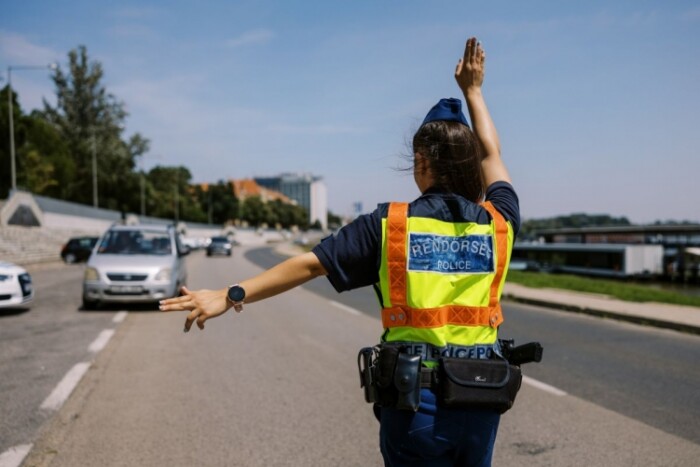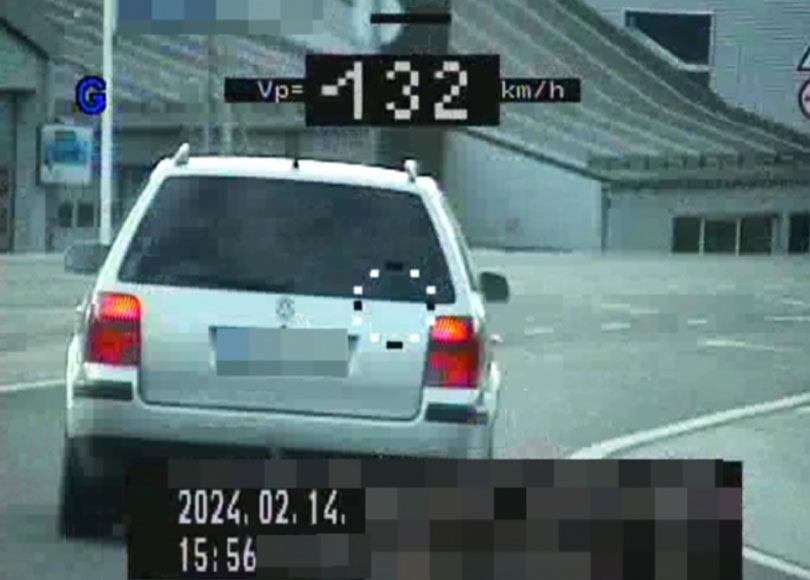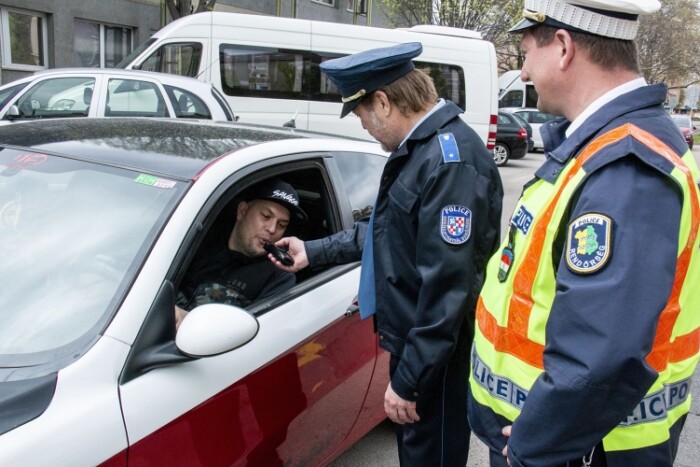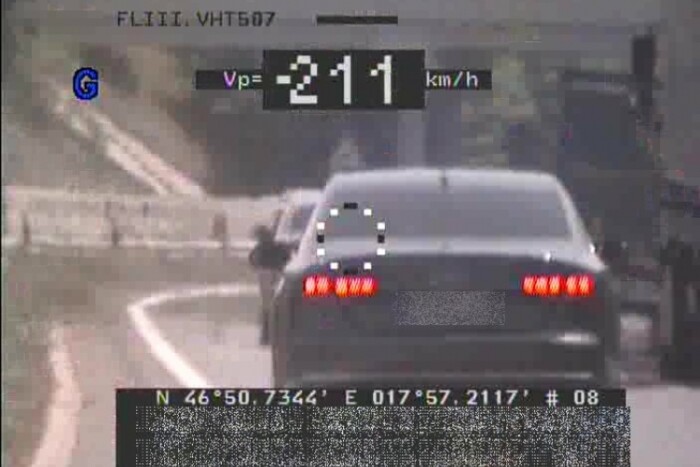From cutting off the right foot pressing the gas pedal to simply impounding powerful muscle cars, ideas fly under the news about extreme speeders. 213 km/h speed at table 90, 132 km/h at 50, and so on – the state is currently trying to discipline drivers who break the rules using traditional methods, with fines and penalty points. The police caught a record number of speeders last year, and there seems to be more and more coverage of crazy speeders, so the question arises: what is the situation with the drivers who collect the most penalty points?
181 km/h at sign 90 on highway 88 (police.hu)
Which nonsense is worth how much?
“In the three years under review, a total of 30,079 clients successfully completed the various continuing education programs,” wrote the Ministry of Construction and Transportation (EKM). The period lasts from the beginning of January 2021 to the end of August 2023. The ministry was unable to send data for the whole of last year due to a government IT transition, but the large number of thirty thousand is still impressive for 32 months.
Before we break down the statistics in detail and tell you what exactly so many drivers – mostly under penalty – did, a few words about the sanctions officially called the lifetime points system.
The police have been handing out penalty points for almost a quarter of a century, and anyone who hasn’t received one in that time can be proud of themselves. How many points are awarded for which offence?
Violation of the obligation to keep to the right is only 1 point, which is partially deducted from the KRESZ that is now being filed. Passing through the closing line and the area closed to vehicle traffic is penalized somewhat more severely (2 points), 3 penalty points for using a hand-held mobile phone while driving, and 4 penalty points for violating the rules regarding the mandatory direction of travel are entered in the drivers’ digital checker. Passing a vehicle stopped in front of a designated pedestrian crossing – without stopping – 5 points, driving on the freeway stop lane 6 points.

Image: police.hu
There are no seven-point penalty points for some reason, but 8 points can be collected for many things, including violations of the rules of crossing a railroad crossing, drunk driving, and exceeding the maximum speed limit. With 9 points, those who cause road accidents are punished, and with 11 points, failure and road endangerment are sanctioned, which are already classified as crimes, and these are the most important.
Of course, you cannot collect indefinitely, 18 is the limit. If the number of points has reached or exceeded this, there is the right. The revoked driver’s license must be returned six months after it was issued, if the driver proves that he took part in refresher training after his license was revoked, and that the other conditions for the driving license defined in a separate law are met. For those who are new to all this and now have 16 points in their pockets, the fact that it is possible to reduce them before the 18 limit can be useful information.

132 km/h at sign 50 in Zalaegerszeg (Photo: police.hu)
How many people completed which continuing education?
Breaking down the 30,000 drivers who took part in the refresher training by year, we see a slight increase (the full data for the year 2023 may be available soon, according to the ministry’s promise). In the last two and a half years, the number of those who successfully completed the task has been like this.
| 2023. I-IX.hó | 8080 |
| 2022 | 11 118 |
| 2021 | 10 881 |
There are a total of six types of retraining, as the crimes committed are diverse. Some may only want to reduce their score after crossing the finish line twice, while others are notorious speeders, the third drives a car because he is an alcoholic, the fourth actually killed a person and had his driver’s license revoked by a court ruling.
We asked the Ministry of Transport for the number of successful candidates according to types of continuing education, after the table there is an important explanation for the numbers.
| I. | II. | III. | V.+I. | V.+II. | V.+III. | |
| 2023.01-09. | 522 | 206 | 2419 | 1594 | 774 | 1611 |
| 2022 | 756 | 272 | 2594 | 2700 | 939 | 2205 |
| 2021 | 677 | 231 | 2570 | 2586 | 770 | 2171 |
| All | 1955 | 709 | 7583 | 6880 | 2483 | 5987 |
Since the data of the various continuing education programs overlaps at several points, we provide the ministerial explanation sent along with their interpretation verbatim.
“Customers who reduce their penalty points (less than 18) within the framework of a voluntary program are in all cases III. program is carried out. In the case of voluntary continuing education, there is no preliminary investigation. Drivers whose traffic history points reached or exceeded 18, and as a result of which their driver’s license was revoked, in the vast majority of cases III. program, but – depending on the results of the exploration prior to the program – it happens that I. or II. they need to complete the program. In addition, based on the professional decision of the exploration team, III. classification for the program can also be given to drivers whose driver’s license was revoked for other reasons (i.e. not because of accumulated traffic record points). The picture is further colored by the fact that, based on the results of the continuing education exploration, the I-II-III. any other customer can be assigned to any of the programs.”
Unfortunately, despite the fact that we wanted to find out for which reason (speeding, drunk driving, etc.) how many motorists fulfill which, according to the ministry’s answer, “only aggregated data can be filtered without distinguishing the specific program in relation to what case (so road traffic record points revocation of driver’s license, voluntary points reduction or other reasons unrelated to the points system) was assigned to the customer.”
However, this III program is out of line, which is why we were particularly curious.

Image: police.hu
What do they do in the III program?
Before that, however, a few words about the so-called about an exploratory occupation, because those who are obliged to continue training must participate in such, this will decide their further fate. “After comparing and analyzing the act(s) committed as well as the results of the exploration, the task of the exploration group is to direct those who are obliged to it to a training program that best focuses on the solution of the dominant problem and handles it most effectively. Based on the assessment of the investigation team, and in each case the composition of the group of drivers assigned to the given program, and at the same time focusing on their unique problems, the training program is tailored to the persons required to be investigated. Accordingly, the programs are unique.”

211 km/h at sign 130 on the M7 (Photo: police.hu)
The program completed by many tens of thousands of motorists in the past decade is a dual-use, pedagogical, training-type (theoretical) classroom activity “conducted using group dynamic methods”. Due to the nature of the session, it typically takes place in a classroom with a semi-circular arrangement instead of rows of desks, roughly the same way we see the seating order of conversations between people who once had alcohol problems and ex-drug addicts in the movies.
The III. the program is run by two people: a traffic specialist and a psychologist.
Since the drivers participate in this program mostly because of traffic violations, they complete self-knowledge, personality, and traffic psychology tests during the sessions. These are then jointly evaluated, so that the mistakes made by the group members become known to all participants, and their joint solution increases the efficiency and dynamics of the training.
In addition, they conduct conversations on traffic culture and behavior, and receive explanations of rules and regulations in order to recognize dangerous situations, apply the rules appropriately, and develop and strengthen rule-following behavior.
Source: www.vezess.hu


